How You Can Have Your Own Video Podcast Show
By Keith Brunson
If you're wondering how you could have your own video podcast, this story is for you. Today, Creative Media Design announces the offer for you to have your own show, and Digital Video Producer Mark Pressman is leading the charge. "The analog days are over, and with this new digital movement across the world, people from all walks of life who are not professional broadcasters can have their own TV show online," says Pressman.
The goal will be for anyone who wants to have a show can now actually have it at a Very affordable price, and this project is headed up Under the leadership of Pressman himself. And this is not Just for big business. This is for you, the reader, to be enabled under the supervision of Mark Pressman himself. "I have always been motivated by technology which allows people to have their own YouTube channel," says Mark. "we'll offer a turnkey solution for an on-going show or a one-time-only video podcast."
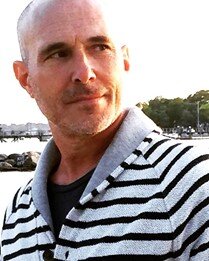
Mark Pressman is leading the Video Podcasting program at Creative Media Design
Lia Perretti is the Head of Production/Executive producer for Creative Media Design. She's been a content creator for twenty years, long before the world went digital. "I definitely am excited about tying audio and video together so that anybody can become the video podcaster at Any location they want," says Lia. "When people come to us, they'll identify right away, that we are the people who can make this happen" https://cmdnyc.com

Creative Media Design's Head of Production and Executive Producer, Lia Perretti.
The options are multi-fold. There are shows that can be produced from our New York studio. Or an alternative, you can do it from your location, no matter where you are in the world, says Pressman, "And under this show plan, I can ship people the equipment for the show and be their advisor on all aspects of which are technical and hard to understand," says Mark. "So, we're getting rid of the mystique of what it takes to have your own show and coach the person from concept to completion."
The choices are multi-fold. You can come to our studio here in Manhattan. Or you can do it from a studio in your hometown, or even do it from your home," says Pressman, "and that'll eliminate the smoke and mirrors of just exactly how the video podcast is done."

Video podcasting and coaching are available in the CMD studio or your own home.
Ironically, it was the pandemic that brought on this new industry. People now have learned that they like working at home, and under this value proposition, anyone can have a show on the topic they want. And then, once produced, Pressman will post-produce the show. "We can edit it for them, add graphics, videos, music, and polish their product to perfection," says Mark. "It'll look just like a broadcast-quality show." And it goes further from there. "We can create them a set, and when we edit for people and it'll be a virtual edit so they can call the shots," adds Pressman. "We don't even have to meet the client." This concept is simple, "but because it's technical, it's not easy to self-configure." And that answers the question of what people become concerned about the most. So, just how does this get on YouTube? "No question it's a technical matter, and so many people don't have an understanding of how it works," says Mark. "But they will once we teach them."
Creative Media Design will offer coaching to the interviewer and interviewee. So as Lia Perretti tells me, who has an ad agency background as a producer, "I'm in the business of KEEPING a client, and that comes from being of service to at all levels of the production process." Lia is right. Everyone who aspires to do this wants a team to talk to at all times, and that is Now available.
So, what IS the equipment that is used, and how does this all flesh out? "We believe for home use, the iPhone Pro Max is the camera of choice," comments Mark. "And simple ring lighting is supplied by us, or they can buy it themselves." A price check reveals that the lighting can be as inexpensive as 49-dollars from Walmart. Yes. Walmart, Best Buy. Public retail outlets that sell ring LED lights are all that is necessary. "Sound quality is vital, and we advise people on what microphone to use," add Pressman. "And then, we route it through Wi-Fi or the ethernet."

CMD will guide you to the best equipment to use for your video podcasting projects.
Cost starts at $1100 for your own twenty-minute show. Equipment can be leased by Creative Media Design or can be self-purchased. "But no matter what the objective or problem is, we can solve it cost-effectively here at CMD," says Mike Zirinsky, Chief Executive Officer. "Video is new here at CMD, and although we've done shows in our studio here, this proposition is timely because it allows people the freedom to learn the business with no holdbacks and get involved at the professional level."
The offer even includes a CMD crew that'll come to you. "We'll be your studio," says Mark Pressman, "and suddenly, your video podcasting on the internet." And the cost will depend "On what level of production they are looking for," adds Zirinsky. "The idea is to serve everyday people at their level of need."
Naturally, big business wants a different look than an individual starting their own show. And this new service allows multi-camera podcasts to be produced or just a simple one-camera set up for the aspiring podcaster. "We can deliver a live-stream or recorded show," says Pressman. "The options are unlimited, but it all depends on who it is and what they want."
So, if you are wanting your own podcast produced from top to bottom, now, Creative Media Design opens its doors to everyone. "We know that there are a lot of people that want to do this but just don't know how," says Mike Zirinsky. "The Idea is to be the entire production team at a Very affordable price for anyone that wants to be a content creator for the world market."

Creative Media Design's CEO, Mike Zirinsky, offers a production team
to anyone who wants to create professional video podcasts.
And that means that if you have been thinking about having your own show, you can now have a team that will help from script to screen. There was a time when the secrets of broadcasting, music, and video were knowledge of the privileged few. "But those days are gone," says Mike Zirinsky. "The door is now open to Anyone anywhere on any topic to have their own show." And now it IS possible for anyone but the elite.
Why the Microphone Matters in Voice Overs
By Keith Brunson
We all know Stevie Nicks, the singer for Fleetwood Mac. We know her songs; we know her voice. But none of us know her microphone. Yet this mechanical object is the only mic she will sing through and is a small part of why she has such an amazing sound when she sings into it.
But isn’t a mic a mic? Not at all. Just like people, microphones are all different and are engineered with specifications that deliver amplification and recording for various purposes.
The microphone itself was first invented by Emile Berliner with Thomas Edison in 1876. Historians say it was Alexander Graham Bell. Before then, audio had never been recorded. In 1892, a legal squabble between all parties resulted in the Supreme Court ruling that Thomas Edison would be forever credited as the inventor of the microphone we know today.
There’s so much confusion about what the correct microphone is to use for the voice over artist. There are many choices, and they’re all microphones. So, today we will explain it and dig deep into why the microphone is such an important choice for voice talent.
But first, what exactly is the microphone, and how does it work? Here we go. A microphone or mic is a device-transducer that converts sound into an electrical signal. The vibration of an object causes its surrounding air molecules to vibrate. This vibration creates a trajectory of changing air pressure that travels until it inevitably loses energy and comes to a halt. And so, due to electromagnetism, a concept of physics that involves electric conduction moving in a magnetic field to generate an electric signal.
That’s the explanation. If you understand that, you are rare. Most voice actors, musicians, and sound engineers make a calculated choice as to what kind of mic they use and why they use that mic.
There are four types of microphones: dynamic microphones, large-diaphragm condenser microphones, small diaphragm condenser microphones, and ribbon microphones. And dynamic microphones are the workhorses of the microphone world.
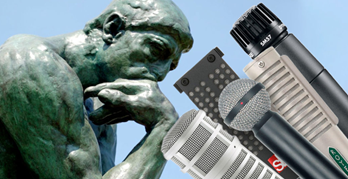
Which mic to choose for voice work? Out of the four types available,
dynamic microphones are used the most.
It’s highly technical and goes on and on. But today, we’re here to learn how to choose the right microphone and reveal the choices of some of America’s professional vo artists.
There are many experts, but Susan Berkley is one of the countries ultra-successful voice artists, “and I use the Bottle baby blue and the AKG 414,” says Susan. “We had a shootout among colleagues, and the baby Blue wins.”
Conversely, Tom Taylor of Austin, Texas, a cinematographer, uses “the Sennheiser 416, and it gets a really great sound for interviews and cutting television show voice tracks.” Tom is a nationally known videographer who has shot and recorded some of the nations’ most well-known television shows.
Podcaster Joe Rogan uses the Shure SM7B, as did Michael Jackson. Dr. Dre uses the Akai MPC 3000 or the Neuman U-87 TLM 193. But voiceover artist Jeff Lillicotch uses the StellarX2 by Tech Zone. “The XLR large-diaphragm made my voice sound much better,” says Jeff, who reinvented his life following a television career. “It just made my voice sound really good.” Jeff, 51, is a commercial production specialist who lives in Houston, Texas, and comments with confidence, “That mic just works for me perfectly.”
Jeff is the go-to guy for automotive advertising. “I get compliments on my voice when I use that mic,” says Jeff. “It really is a great microphone.”
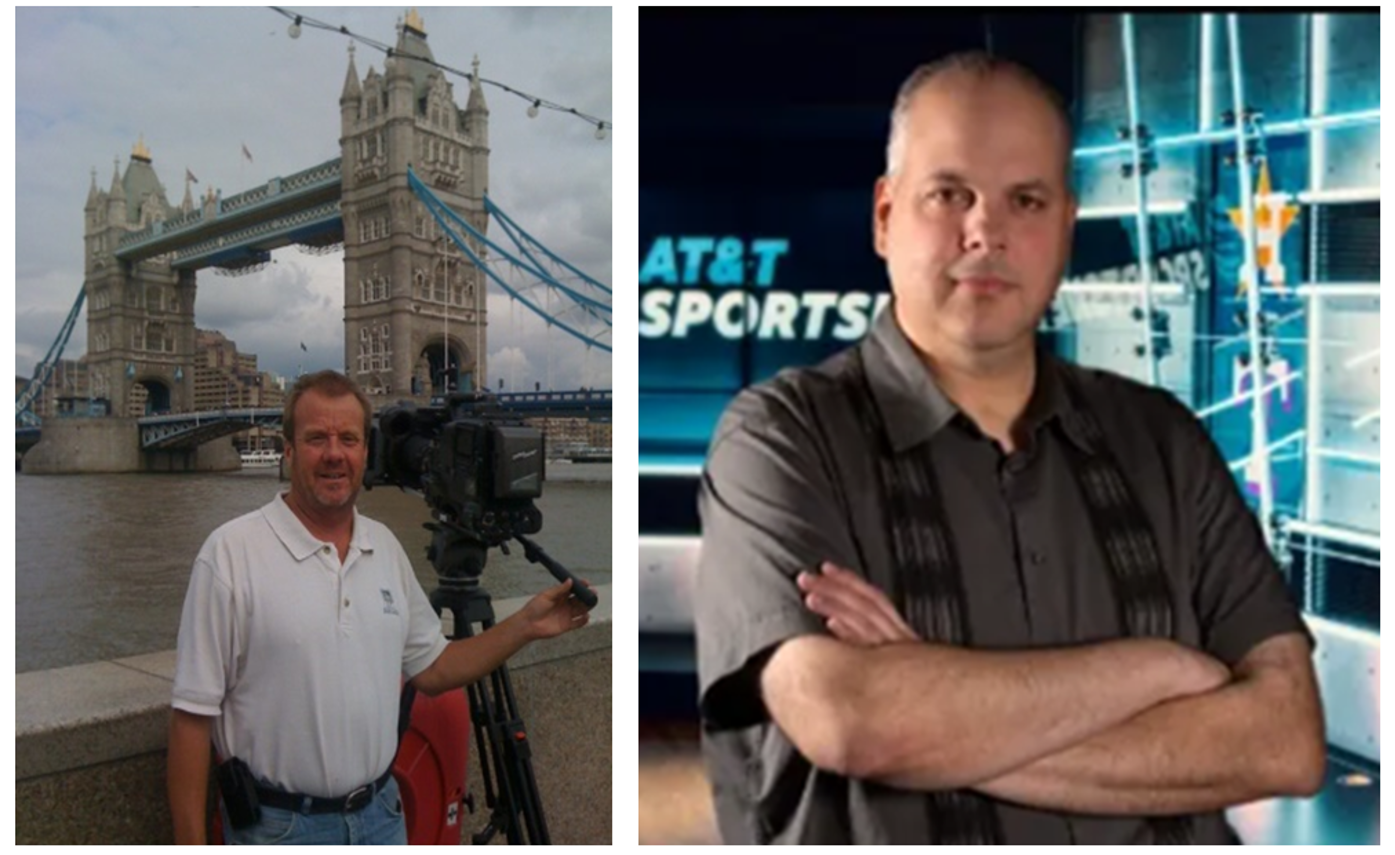
Cinematographer Tom Taylor (left) uses a Sennheiser 416 microphone for TV voice tracks, while voice over artist Jeff Lillicotch (right) prefers the StellarX2.
By now, you are probably wondering how do I get the right advice? The answer is to learn. “We teach microphone technique,” says voice coach Mike George of The Voice Shop in our class “The Fundamentals of Voice Over.” However, other classes that teach how to construct an In-Home Studio are offered and instruct the very best microphone choices based on your vocal timbre.
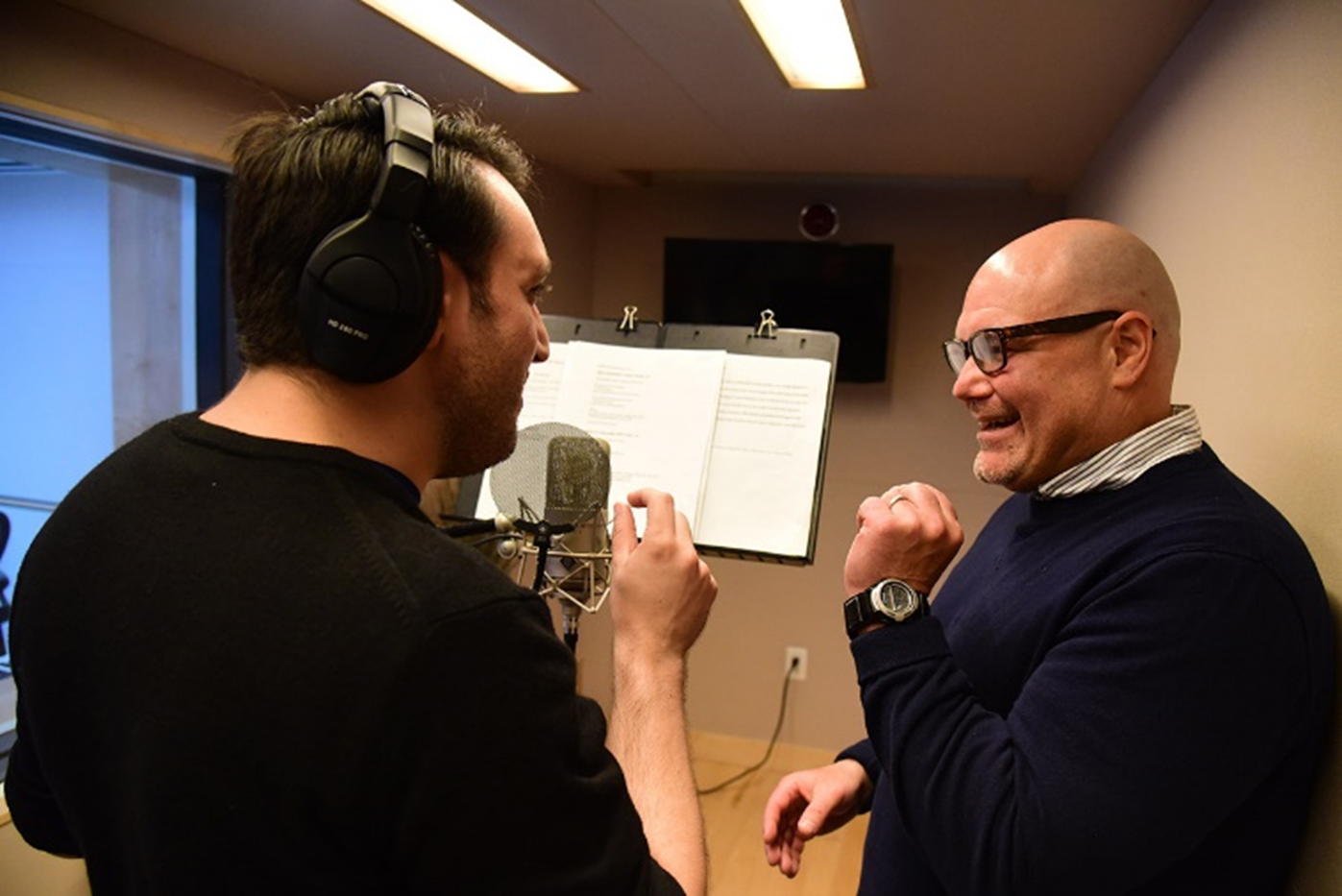
Learning microphone techniques is part of The Voice Shop’s curriculum.
Now, if you think your voice is not good enough to be a VO artist, here’s why. It’s called Vocal Disparity. We’ve been listening to ourselves our whole life, “from inside our heads where the bones of our skull distort our voice,” says Susan Berkley. And that translates to the fact that you may have a voice of value to the world market. In other words, you could very possibly have a place in voice-over work but not know it. “We sound differently to ourselves than we sound on a recording,” says David Dee. David is a former magician who reinvented his life as a professional speaker in marketing.
For voiceover artists, the workhorse of the VO world is the TLM 103. And that’s the microphone Howard Stern uses. And Voice Over Artist Andy Pearson chimes in on the 103 “It’s what I used when voicing for Eaton corporation,” he says, “I know it improved my voice.”
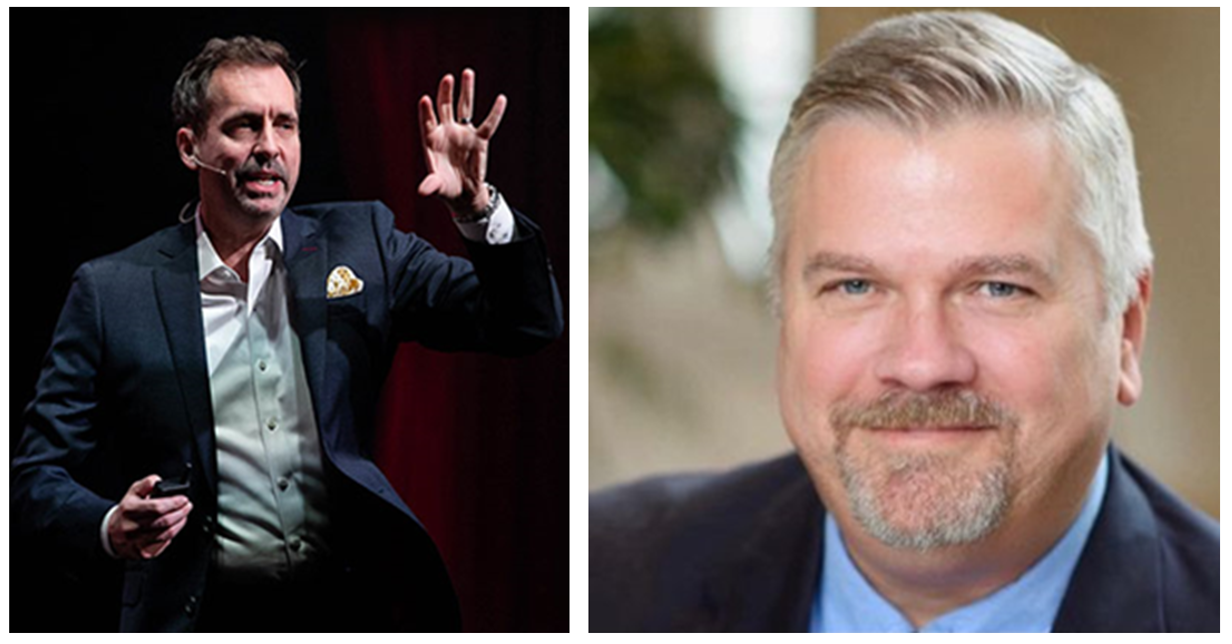
Former Magician-turned-professional speaker David Dee (left) and voice over artist Andy Pearson underscore the importance of getting the right microphone for your voice.
That microphone is revered by many artists of the voice who wants a good clear sound. Yet, even more, choices remain. How many? Quite a few.
So now that you’re overwhelmed, where can you find out what to buy, how to use it, and what you will learn? One place is Creative Media Design , a voice over production studio and their sister company, The Voice Shop. Here, the student can obtain one voice course or a host of voice courses that train the aspiring voice-over artist from concept to completion on all voice-over matters. “Classes there changed everything,” comments Victoria Mussalli, a graduate of The Voice Shop. “It changed everything,” she says.
And so there you have it. The microphone is quite complex but made easy to understand and used to enlighten the qualities of your voice. And as for Stevie Nicks, she uses the Sennheiser e935. Word has it from her touring sound engineer David Morgan, “Stevie won’t sing without it.”
